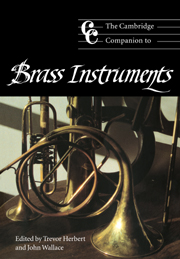Book contents
- Frontmatter
- Introduction
- 1 Lip-vibrated instruments of the ancient and non-western world
- 2 How brass instruments work
- 3 Design, technology and manufacture before 1800
- 4 Brass instruments in art music in the Middle Ages
- 5 The cornett
- 6 ‘Sackbut’: the early trombone
- 7 The trumpet before 1800
- 8 The horn in the Baroque and Classical periods
- 9 Design, technology and manufacture since 1800
- 10 Keyed brass
- 11 The low brass
- 12 Brass in the modern orchestra
- 13 Brass bands and other vernacular brass traditions
- 14 Playing, learning and teaching brass
- 15 The post-classical horn
- 16 Jazz, improvisation and brass
- 17 Brass solo and chamber music from 1800
- 18 Frontiers or byways? Brass instruments in avant-garde music
- Glossary
- Notes
- Select bibliography
- Index
7 - The trumpet before 1800
Published online by Cambridge University Press: 28 September 2011
- Frontmatter
- Introduction
- 1 Lip-vibrated instruments of the ancient and non-western world
- 2 How brass instruments work
- 3 Design, technology and manufacture before 1800
- 4 Brass instruments in art music in the Middle Ages
- 5 The cornett
- 6 ‘Sackbut’: the early trombone
- 7 The trumpet before 1800
- 8 The horn in the Baroque and Classical periods
- 9 Design, technology and manufacture since 1800
- 10 Keyed brass
- 11 The low brass
- 12 Brass in the modern orchestra
- 13 Brass bands and other vernacular brass traditions
- 14 Playing, learning and teaching brass
- 15 The post-classical horn
- 16 Jazz, improvisation and brass
- 17 Brass solo and chamber music from 1800
- 18 Frontiers or byways? Brass instruments in avant-garde music
- Glossary
- Notes
- Select bibliography
- Index
Summary
The late Renaissance (1500–1600)
Trumpeters seem to have enjoyed Imperial protection in the Habsburg empire by the fifteenth century. In 1548, the Imperial Diet of Augsburg decreed that trumpeters and others were allowed to form guilds. The decree was confirmed in 1577, leading to the founding of the Imperial Trumpeters' and Kettledrummers' Guild in 1623.
Three surviving manuscript collections allow an insight into the court trumpeters' military and ceremonial repertoire of the late Renaissance: the notebooks of two German trumpeters at the Danish court, Magnus Thomsen (1596–1609) and Hendrich Lubeck (1598), and a trumpet method, Tutta l'arte della trombetta, compiled in the 1580s and written down in 1614 by the Munich chief court trumpeter, Cesare Bendinelli (c. 1542–1617). All contain exercises, military signals and ensemble pieces.
Monophonic military music to c. 1600
The oldest surviving trumpet signals, codified in Italy during the sixteenth century, were executed in the low register of the trumpet, from the second to the fifth or sixth partial of the harmonic series (C3 to E4 or G4). They were preceded by an introductory ‘toccata’; later a concluding third part was added. Bendinelli remarked that the style of execution should be free, ‘with little regard for the beat’.
Other kinds of monophonic trumpet signals were played at special events such as announcements of university promotions or jury verdicts, or to summon the gentry to table. They were also included in theatre pieces, including many of Shakespeare's plays, where they were called ‘tuckets’ (a word with an obvious etymological connection with ‘toccata’).
- Type
- Chapter
- Information
- The Cambridge Companion to Brass Instruments , pp. 84 - 102Publisher: Cambridge University PressPrint publication year: 1997
- 1
- Cited by



